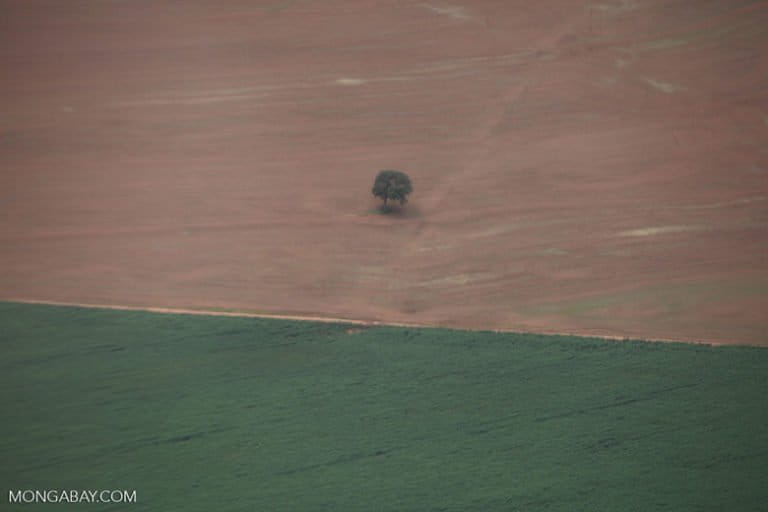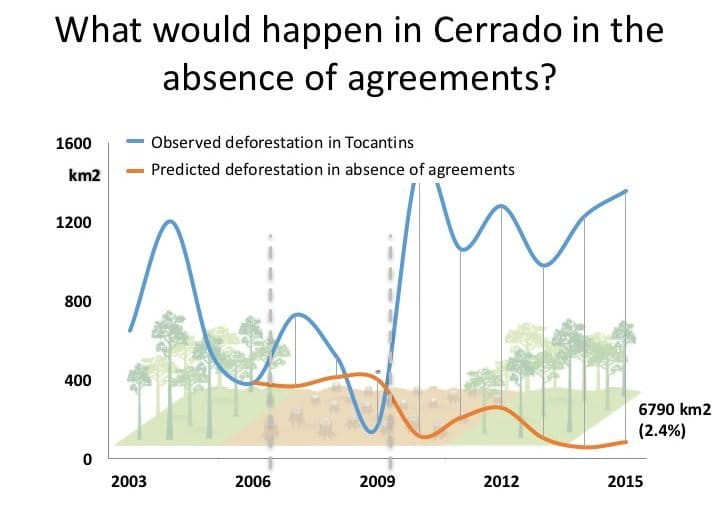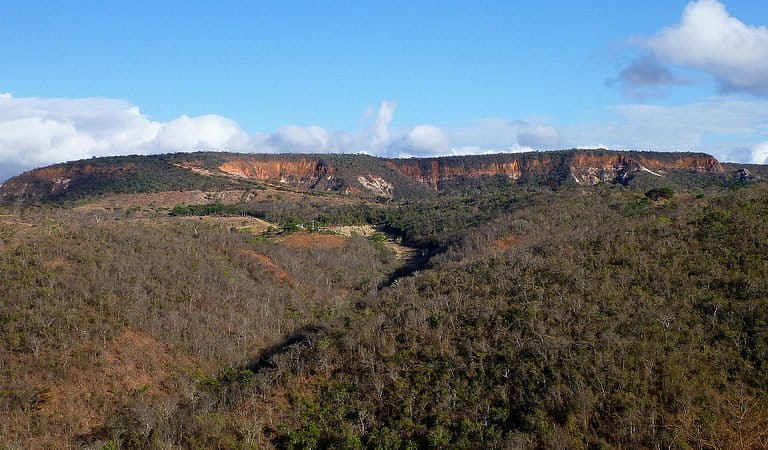- In the early 21st century, Amazon biome deforestation decreased, as native vegetation loss began rising dramatically in the Cerrado savanna biome in Brazil. Now, scientists using a new research methodology known as telecoupling, have found that the Amazon deforestation decline and Cerrado increase are linked.
- The effect, known as spillover, resulted as two zero deforestation conservation agreements – the 2006 Soy Moratorium and 2009 Brazilian Federal Prosecutors’ Terms of Adjustment of Conduct (TACs) – prompted commodities traders and ranchers to stop buying soy and cattle raised on newly deforested Amazon land.
- However, a portion of this agribusiness activity simply relocated to the Cerrado. The research team notes that this deforestation spillover effect – resulting from regionalized conservation initiatives – had been neglected by conservationists in the past because the underlying mechanisms are difficult to identify.
- The researchers suggest that telecoupling can be used in future research to understand the influences of conservation policies and supply chain agreements, whose impacts are displaced between biomes, countries and even continents. Telecoupling as a tool is especially important in a globalized, interconnected world.

Photo credit: Saulo Cruz on Visualhunt.com / CC BY-NC-SA
Impressive past reductions in the rate of Amazon biome deforestation in Brazil have been counteracted by major increases in deforestation and native vegetation loss in the neighboring Cerrado savanna biome, according to a study recently published in the Journal of Geographical Sciences.
Two multilateral zero deforestation agreements – the voluntary 2006 Soy Moratorium and the 2009 Brazilian Federal Prosecutors’ Terms of Adjustment of Conduct (TACs) – disallow commodities traders from purchasing soy and cattle raised on newly deforested land. Both, while imperfect mechanisms, have been linked to significant reductions in Amazon deforestation in the 21st Century.
However, few attempts have been made to quantify the extent to which such successes in one region have simultaneously caused an increase in deforestation in less-well-protected areas, such as the Cerrado in the northeast of Brazil.
To address this question, a team led by Yue Dou, a researcher in human and natural systems at Michigan State University, modeled several interrelated factors – the impacts of the two agreements, the price of soy and beef, and available land and local infrastructure – on the rate of loss of native vegetation in the state of Pará in the Brazilian Amazon, and Tocantins state in Brazil’s Cerrado. The scientists used a multi-disciplinary method known as the telecoupling framework for their analysis.
The researchers found that while the rate of deforestation in Pará dropped from 7.8 percent in 2003 to 2.5 percent in 2015, this was partly due to the displacement of soy plantations and cattle ranches from Pará into Tocantins, where the deforestation rate accelerated from 0.36 percent to 0.8 percent over the same period.

“The Soy Moratorium, an agreement that was intended to save forests in the Amazon, still caused deforestation, just in a different place – the Cerrado,” Dou explained.
The team noted that this deforestation spillover effect, resulting from regionalized conservation initiatives, has been neglected by the scientific community in the past because the underlying mechanisms are challenging to identify, with their impacts potentially displaced between biomes, countries and even continents, Dou said. That’s where the telecoupling framework can be especially useful.
Telecoupling was first proposed as a methodology in 2013 by Jianguo Liu, study co-author and director of the Centers for Systems Integration and Sustainability (CSIS) at Michigan State University. It allows natural and social scientists to identify and track distant interactions at a global scale by modelling the flow of materials, information and money between focal systems, while also identifying the resulting socioeconomic and environmental effects that spillover from system to system.
“If you think of global sustainability as a high-stakes jigsaw puzzle, telecoupling is a way to bring scientists from all disciplines together to assemble the big picture without losing any pieces,” said Dou. “It’s a way of recognizing reverberations of actions and interactions that traditional studies of single systems cannot.”
“This method elucidates the influences of policies and supply chains [whose] impacts and responses flow over great distances,” agreed Gillian Galford, an earth systems scientist at the University of Vermont who was not involved in the study. She added that telecoupling offered “a useful approach to understand a range of factors influencing local losses of Cerrado for agricultural use, particularly for soybean commodities.”
The research team found that annual deforestation in Pará dropped from 11,013 square kilometers (4252 square miles) in 2003, to 1714 square kilometers (662 square miles) in 2015. These results are in line with national statistics, such as those published by Brazil’s National Institute of Space Research (INPE) which reported an 80 percent deforestation reduction in Legal Amazonia, from 22,772 square kilometers (8,792 square miles) in the year 2000, down to 6,207 square kilometers (2,397 square miles) in 2015.

Using telecoupling models, Dou and her team calculated that the 2006 Soy Moratorium and the 2009 Zero Deforestation Agreement were collectively responsible for halving deforestation in Amazonia compared to projected rates if the agreements had never been put in place.
However, 700 miles away in Tocantins, conversion of native vegetation into pasture and cropland soared to 7,944 square kilometers (3,067 square miles) after 2007 – a loss more than six times higher than the 1,206 square kilometers (466 square miles) projected if the Soy Moratorium and TACs hadn’t gone into effect.
The Cerrado – a vast expanse of dry forest, shrubland and grassland – once covered 2 million square kilometers (772,204 square miles) in Brazil’s northeast, but the biome has suffered dramatic deforestation as a result of agricultural expansion, particularly due to lucrative large-scale soybean plantations which began arriving in the region as early as the 1960s, but which exploded in area in the 21st century.
“This [study] is an important recognition of land use changes in the Cerrado, [and] particularly unintended consequences of reducing deforestation in the Amazon,” said Galford.

While the ecological worth of the Amazon is well known in the developed world, the worth of the Cerrado biome tends to be undervalued. However, it offers a home to thousands of endemic plant and animal species, and is vital as a Brazilian watershed. The Cerrado is the source of eight of the country’s twelve major rivers, and feeds three key water aquifers – the vast Gurani aquifer extending beneath Argentina, Brazil, Paraguay and Uruguay, and the smaller Bambuí and Urucuia aquifers in Northeast Brazil. But residents recently reported water levels dropping and springs running dry here. This is likely due to a combination of factors, including native vegetation loss and soaring water consumption, mostly due to expanding agribusiness; along with climate change, which has brought deepening drought to the biome.
Currently, up to 80 percent of privately-owned lands in the rural Cerrado can legally be converted from native vegetation to either cropland or pastureland. But once converted to pasture, native flora and fauna is slow to recover. A recent study found that abandoned pasturelands have not regained their former biodiversity, with sites still harboring 37 percent fewer species some 25 years on.
Agricultural land there is also much less efficient at recycling water back into the atmosphere because it typically is only covered in plants for a portion of the year. Plants release water into the air as they take in oxygen, a process known as transpiration. But during the fallow season, when crops aren’t grown and when the ground is bare, water in the soil can only return to the sky via evaporation. Recent satellite data suggests that soy plantations recycle 60 percent less water than native vegetation during the dry season. Also, soy cropland in the Cerrado recycled 3 percent less water in 2013 than expected from native vegetation.
This reduction in water cycling, now seen in the Cerrado, may ultimately reduce rainfall over the Amazon rainforest, completing the circle of cause and effect between the two systems. Noted climate scientist Carlos Nobre and biologist Tom Lovejoy have warned that increased deforestation in Brazil could, over time, lead to a tipping point where large portions of the Amazon, due to intensifying drought, would convert from forest to savanna, impacting the regional and even the global climate. More frequent droughts in the Cerrado could help force that Amazon tipping point, though more research is needed to know for sure.

In an effort to protect the precious Cerrado habitat, and the natural services it provides, the World Wide Fund for Nature (WWF) and Greenpeace developed the Cerrado Manifesto in 2017. The voluntary conservation agreement, which seeks to eliminate the conversion of native vegetation for agriculture or livestock in the biome, has now been signed by more than 70 large corporations, including fast food and supermarket giants McDonalds, Tesco and Walmart. Earlier this month, APG and Robeco became the latest companies to sign the manifesto.
However, Cargill, Bunge and Amaggi – major transnational commodities companies that source agricultural products from the Cerrado – have yet to sign the agreement. It was these same firms and others that agreed to the 2006 Amazon Soy Moratorium, perhaps partly because they knew they could readily source their soy next door in the Cerrado.
The new study shows that “conservation efforts in the Amazon and global factors have not lessened the ‘sending’ of land use change to the Cerrado,” says Galford. Simply put, all biological systems are connected; pull a thread and multiple biomes can begin to unravel.
Unfortunately for the Cerrado’s native vegetation, resistance to increased federal protections remain strong there. The politically powerful bancada ruralista agribusiness lobby, formed, in part, as an angry reaction to the strengthening of Amazon environmental regulations, wants no part of savanna conservation.
The current Brazilian Forest Code permits conversion of just 20 percent of rural properties for agriculture or livestock in the Amazon, a provision that needs to be extended to the Cerrado to preserve it, according to experts. But it seems unlikely that the pro-agribusiness National Congress and President elect Jair Bolsonaro, due to take office in January, will support similarly tough rules in the savanna, Brazil’s latest agricultural frontier.

The first step to designing agribusiness policies and conservation measures that don’t produce counter-productive spillover effects is to acknowledge the problem, said Dou. Key stakeholders from all affected ecosystems need to be involved in agricultural and environmental policymaking and conservation initiatives, looking at potential widespread effects right from the start, in the design stage, and aim to “minimize and avoid negative effects while maximizing positive effects with fairness, responsibility, and capability.”
With this goal in mind, in 2009 Lui and colleagues set up CHANS-Net, an international network of about 1,800 researchers across the natural and social sciences, which promotes collaboration to tackle global issues. “Progress in sustainability must be genuine and we can’t allow ourselves to be blinded by success in one place at the expense of invisible impacts on other places,” he explained.
Agricultural intensification – increased yield through better crop and livestock management – could also alleviate some of the deforestation pressure on the Cerrado, while a variety of supply chain sustainability certification efforts could give global consumers more influence over suppliers and retailers. “Sustainability is best achieved when both people and nature can thrive,” concluded Dou.
Citation:
Dou, Y., da Silva, R.F.B., Yang, H. et al. Spillover effect offsets the conservation effort in the Amazon. J. Geogr. Sci. (2018) 28: 1715. https://doi.org/10.1007/s11442-018-1539-0
FEEDBACK: Use this form to send a message to the author of this post. If you want to post a public comment, you can do that at the bottom of the page.
